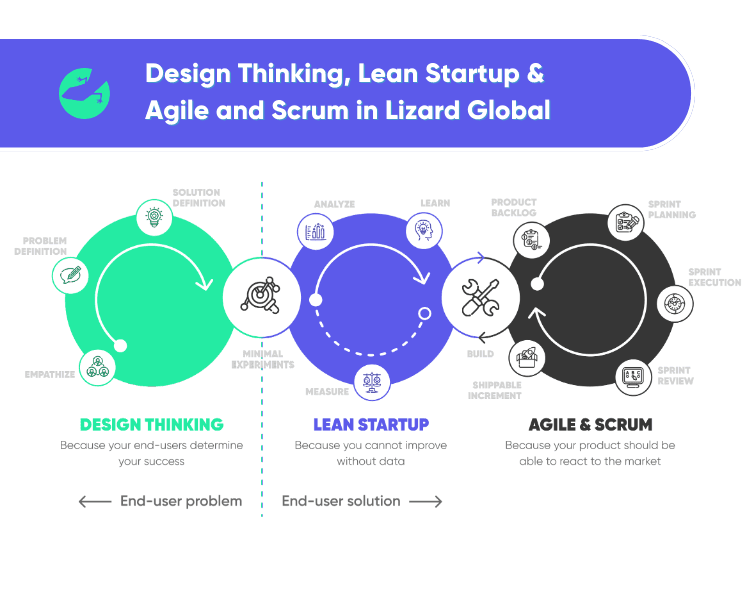The Ultimate Software Development Workflow Strategy
Get the latest updates about our blog posts.
Subscribe so you don’t miss out!
Follow Lizard Global on Facebook, Instagram, and LinkedIn.
Hey there! Ever wondered how the way your team tackles software development could really make or break your projects? Well, we're here to chat about it in a way that won't put you to sleep.
Check out our guide on crafting the ultimate software development workflow. We'll spill the beans on what makes a workflow tick in software development, throw in six nifty ways to jazz up your development flow for constant improvement, and dive into the hurdles Agile teams often face. Oh, and we'll wrap things up with some tips on how you can level up your workflow game by assembling a stellar team. Cool, right? Let's get into it!
📣 What is Software Development Workflow?
So, what's the deal with workflows in software development, you ask? Well, think of it as the magic thread that ties together all the stages of software development, or as the cool kids call it, the Software Development Life Cycle (SDLC). It's like the secret sauce that helps software developers whip up their applications with some serious efficiency.
Picture this: a software development workflow is like a never-ending loop, guiding developers through each stage and giving them a sneak peek into what comes next. With this game plan in place, a software development team can:
- Get a bird's-eye view of the entire project
- Clearly define who's doing what in the team
- Connect the dots between their work and the project as a whole
- Anticipate and dodge any project roadblocks
- Tackle challenges head-on during app development
- Spread their resources like pros
- Amp up their performance on the current project and future app-building adventures.
In a nutshell, a killer workflow isn't just a roadmap – it's the secret sauce that makes a software development team rock!
⚡ Elements of a Software Development Workflow
Alright, diving into the nitty-gritty of a Software Development Workflow, we're talking about a bunch of technical components that make this whole thing tick. Before we jump into making it better, let's break down what we're working with.
So, this dance is also known as the systems development lifecycle (SDLC), and it's basically the step-by-step plan for mapping out, constructing, testing, and rolling out a software application. To whip up top-notch software in record time, your team needs to stick to this tried-and-true SDLC. It's like the secret recipe for cooking up quality software!
Phase 1: Project planning
Getting the ball rolling on your Software Development Life Cycle (SDLC) involves some serious planning and role-assigning within your dev team. Before you dive in, you've got to take a good look at a few key things to make sure you're all set to kick off the project:
- Product requirements or scope: What features and functions are a must-have for the software, website, app, or service you're cooking up? What's the client's wishlist, and are there specific branding rules to follow?
- Alignment: How does this project align with your big-picture business mission and goals?
- Project scheduling: When's kickoff, and when's the grand finale? How's your team tackling this – every day, a couple of times a week? If they've got other projects on the go, where does this one fit in?
- Resource availability and allocation: Take stock of your squad – do you have the tools and talent to handle this, or do you need to beef up the team? Sketching out a resource plan beforehand helps you see this crystal clear.
- Cost estimation: What's the damage? Break it down, so you've got a clear picture of the estimated costs.
- Requirements: Dive deep into the nitty-gritty of the project – what problem is it solving? Who's using the product, and how? Do you need new tools, platforms, or APIs? What's the deal with data and privacy?
- Role allocation: Once you've got all that intel, it's time to dish out the roles. Consider everyone's experience, preferences, personality, and skills, and have a chat about who's best suited for what.
The goal in this kickoff phase is to get things started on the right foot. That means pulling input from all the departments in the ring, like IT, product development, QA, operations, business development, sales, marketing, and management.
By the end of this leg, you should have the lowdown to create a rock-solid scope of work (SOW) – a detailed narrative of your project, covering timelines, deliverables, and project-specific activities. A well-crafted SOW is your ticket to hitting timelines, warding off scope creep, and keeping everyone on the same page.
🧐 How much does it cost to build an app in 2024? Fulfill your curiosity with our App Cost Estimator. Totally FREE! Click, calculate, and get ready for the appventure of a lifetime.
Phase 2: Create and design
Moving on to the next phase, it's time to set up and craft the Software Development Environment (SDE). Picture the SDE as a toolkit with both software and hardware goodies that make the magic happen for your dev team. In simpler terms, it's the all-in-one package your crew needs to get down to business. While the specifics can vary between projects and companies, a typical SDE will include the following essentials:
Code editor and compiler: This is the playground where your developers create, tweak, and save code for the project. If your coding rockstars are into compiled languages like C++ and C%, this tool should also be able to compile code.
Command-line interface (CLI): CLIs give your team the power to navigate the file system, create and delete folders – way more potent and precise than your regular graphical user interfaces (GUI).
Version control system: These tools give your devs the superhero ability to share code, save their progress, and keep tabs on different build versions. A prime example? GitHub, the champion of version control.
Now, here's the kicker – using this SDE to whip up your product is often the trickiest part of the Software Development Life Cycle (SDLC). Your team needs to tread carefully because a slip-up could mean a trip back to the planning stage, especially if you're following step-by-step methods like the Waterfall approach. That's where sticking to the Scope of Work (SOW) becomes the golden rule. It keeps everyone in sync and wards off any unwanted expansion of project scope.
Phase 3: Review code quality and errors
Once your team wraps up the product assembly, it's showtime in the beta environment for some thorough testing. The development team teams up with QA to dive into testing, tracking, and nipping bugs in the bud. Once the product gets the green light for release, your crew gears up for another round of meticulous testing, which might include:
- Rolling out the product to a select bunch of beta testers.
- Utilizing user experience (UX) tools to closely monitor and analyze how users are getting cozy with the product.
Testing can stretch out, especially when dealing with intricate software. But hey, it's the crucial step to ensure you're not shipping out glitchy products to your customers. Bugs, glitches, and performance hiccups can:
- Devour valuable development hours that could've been put to better use.
- Tarnish your hard-earned reputation.
- Cut into your return on investment (ROI).
Phase 4: Deploy and test
Once you've tackled and squashed all those bugs, lags, and pesky issues, the next move is getting your software out to the actual users. Many companies streamline this process by employing an Application Release Automation (ARA) tool or embracing a continuous deployment model.
But hold the celebration because the Software Development Life Cycle (SDLC) isn't hitting the brakes just yet. Post the grand release into the wild, it's maintenance mode. You've got to keep a watchful eye on your software to ensure happy customers and uninterrupted service. Plus, it's an ongoing gig – you've got to keep running tests based on the ever-evolving needs and demands of your users. The SDLC is more of a marathon than a sprint!
🥇 How to create the ultimate Software Development Workflow strategy
Companies have numerous options to enhance their Software Development Life Cycle (SDLC) workflows, many of which become apparent when handling multiple software development projects. Drawing on our extensive experience in the global software development market, we've identified and compiled the best practices for software development workflows. Let's dive into a closer examination of these practices.
1. Prioritize code quality instead of excessive documentation
Certainly, having well-defined and transparent procedures for product development forms the foundation for robust software. However, in many cases, the speed at which a product reaches the market outweighs the significance of detailed documentation during the application release. It's crucial to swiftly present your product to customers, ensuring it captivates potential users effectively.
To steer clear of excessive documentation, saving resources, time, and money, software developers take the following measures:
- Introduce additional product-testing activities into the development phase.
- Conduct regular code-review meetings.
- Uphold coding standards consistently throughout the development process.
- Develop a product MVP (Minimum Viable Product).
2. Opt for a Project Management Tool to delegate roles in your Project Team
While many companies still rely on manual role assignments through meetings, phone calls, and emails, this approach suits smaller companies and projects. For larger enterprises, using a project management tool to allocate roles within project teams is a game-changer. The right project management tool empowers project managers to:
- Assign tasks and roles seamlessly through a user-friendly interface.
- Tailor schedules to align with specific project requirements.
- Anticipate and mitigate risks proactively.
- Generate detailed reports, charts, and documentation.
Leading project management tools, such as GitHub, stand out as examples. GitHub, a widely embraced version control system among software developers globally, facilitates the storage and sharing of application versions, efficient code reviews, tracking the history of code changes, and more.
3. Embrace an Agile Approach
The iterative process is an approach embraced by software developers, scientists, and others to continuously enhance products and designs. Developers create, test, and release a prototype, then tweak, test, and release a revised version based on customer feedback. This cycle repeats at regular intervals, ensuring continuous improvement.
Unlike the Waterfall method, the iterative process swiftly addresses development issues and adapts to market changes. It facilitates continuous integration and improvement, allowing the team to incorporate lessons learned from previous iterations and refine the software development process continually. Additional advantages include:
- Cost-effectiveness: Changes to project requirements or scope are less costly and more manageable compared to the Waterfall approach.
- Collaborative: Results can be presented to clients and stakeholders at the end of each iteration, allowing them to witness the project's evolution instantly.
- Reduced confusion: Detecting and rectifying flaws in each iteration minimizes misunderstandings that may impact the team and the overall project.
The Agile workflow stands out as the most popular iterative product development process, aiding teams in efficiently delivering value to customers through incremental work known as Sprints. Leading Agile methodologies include Lean Startup and Scrum.

4. Establish an Agile Team
After making the shift to an iterative or Agile approach and securing the necessary tools, the next step is to form your Agile team. Here's the game plan:
1. Introduce two new roles: Product Owner and Scrum Master
Kick things off by introducing two key roles to support the dev team — the Product Owner (PO) and the Scrum Master. Scrum Masters serve as facilitators and coaches for the team, while the PO takes charge of setting project priorities and vision. They're also responsible for curating, refining, and maintaining the team backlog, which comprises tasks and materials awaiting processing.
2. Maintain synchronization
For smaller teams, consider using traditional methods like post-it notes or a physical whiteboard. However, for larger or dispersed teams, opting for digital solutions is advisable to ensure everyone stays on the same page.
3. Keep the momentum going
With the foundation in place, it's time to dive into building and refining the product. If your team is new to Agile, consider bringing in Agile coaches to guide them in adopting Agile values and practices.
5. Define team objectives
To wrap things up, it's crucial to set goals for your entire team by incorporating retrospectives into the Software Development Life Cycle (SDLC). Retrospectives are meetings conducted at the conclusion of each Sprint. During these sessions, the team reviews the recent Sprint by addressing:
- What achievements did the team reach?
- What hurdles did they encounter?
- How can processes be enhanced?
In addition to retrospectives, daily standups are a must. These brief meetings involve the core Agile team, including the Scrum Master, product owners, and developers. While the format may vary among companies, most standups involve team members addressing the following:
- What tasks did I tackle yesterday?
- What am I currently working on?
- What challenges am I currently facing?
🔝 Enhance your Software Development Workflow by growing your internal team
Adopting Agile presents a fantastic opportunity to fine-tune your software development workflow. It's a collaborative, efficient, cost-effective approach that better aligns with market demands compared to Waterfall. Nevertheless, crafting an optimized Agile software development workflow is no walk in the park. Despite the increasing shift towards Agile, some developers still lean towards the Waterfall methodology.
Enter Lizard Global – your solution to this challenge. We offer a pool of pre-vetted Agile talent with proven English proficiency, skills, and experience. Our talent spans various tech stacks and Agile methodologies.
Get in touch with us today to bring on board skilled Agile developers for your team.

👀 How much does it cost to build an app in 2024? Let's crunch numbers together!
We get it, pricing can be a puzzler. But fear not! Our App Cost Estimator tool is here to sprinkle a bit of magic on your budgeting journey. It's as easy as picking your features and voilà—your app investment laid out in front of you. Click, calculate, and get ready for the appventure of a lifetime.
Want to find out how much it costs to build your dream app or web app?




